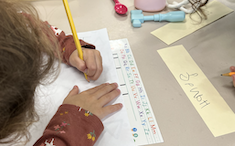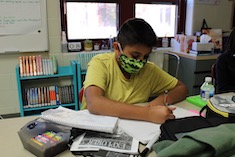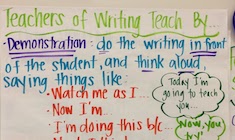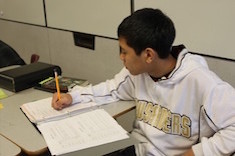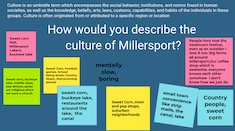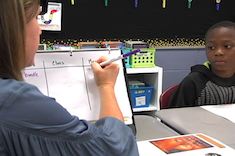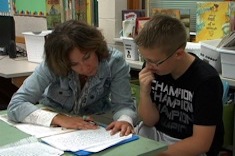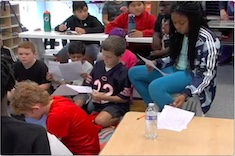Teaching Writing
Everyone who writes for Choice Literacy loves teaching writing, because we all write ourselves. We know it is "hard fun," as Donald Murray famously said—exasperating and exhilarating at the same time. The writing workshops you will read about here and see in our videos are busy, noisy, vibrant places. And most days, we wouldn't want to be anywhere else than in the midst of 'em! Here is where you'll find our latest discoveries, insights, and occasional boneheaded mistakes in teaching writing.
Latest Content
Learning from Our Favorite Illustrators
Ruth Metcalfe tapped a plethora of resources to help her first-grade writers understand how to communicate meaning with illustrations.
Writing Graphic Novels
Melanie Meehan shares the immersion process of writing graphic novels with middle grade students. You won’t want to miss the incredible student writing that shows the power of offering choice to young writers.
Overcoming Challenges in Writing Workshop with Trauma-Informed Practices
Ruth Ayres shares three mindsets to help teachers prioritize connection over correction when teaching writers.
Young Author Celebrations
Jennifer Court shares the celebrations that propel students to engage in the Young Authors Program.
It’s Time to Admire: Sharing in the Beauty of Students’ Writing
Heather Fisher shares a process to help teachers learn to admire student writers and find the beauty in their work.
Opinion Writing in Primary Grades: Layers of Support
Ruth Metcalfe suggests several layer of supports to uplift young writers as they begin to write their opinions.
Taking a Stance: Supporting Opinions in Primary Writers
Josie Stewart and Hannah Tills expand their view of opinion writing to taking a stance, and are reminded of the power of choice and honoring student passions and interests. At the same time, students are reminded that their voice is heard and their opinions matter.
QuickTake: Choice in Making Plans for Writing
Ruth Ayres shares the importance of giving students choice when planning their writing projects.
Questioning My Belief in the Need for Silence
Stella Villalba questioned her belief in the necessity of silent writing time when she began listening to students. In this thought-provoking article, Stella gives direction in how to meet the needs of all students—those who need time to talk and those who need a quiet writing space.
Writing from the Heart
Kate Mills and Tara Barnett pour their hearts into teaching writers, but when Tara loses her family dog, she is reminded that writing is the thing that helps us understand what’s most important.
Authentic Audience
Julie Cox offers three questions to determine authentic audiences for high school students to share work.
Three Ways Student Writers Taught Me How to Use Writing Partnerships
Patty McGee pays attention to how students work as writers to find the teaching points for how to learn to work as writing partners.
Teaching Students to Be Teachers
Tara Barnett and Kate Mills share a process for empowering students to be teachers in partnerships and small-group instruction.
Teaching Writers to Hear Feedback
Cathy Mere outlines ways writers can position themselves to hear (and use) feedback.
It’s the Final Countdown: Using Chunking and Timers to Scaffold Reluctant Writers
What do you do when students won’t write during class? Gretchen Schroeder offers a creative, practical, and effective solution.
Helping Writers Self-Correct
What to do with writers who catch errors in isolation but not in their own writing? Cathy Mere suggests three ways to help students self-correct their writing.
Rural Matters: Revealing Perceptions and Celebrating Roots
Gretchen Schroeder addresses the negative and positive perceptions of rural people with her high school students through readings, discussions, and analytical writing. Download a guide for Critical Rural Perspective Analysis to use with your students.
Good Work, Writer
Becca Burk asserts that every child can become a writer when given materials, opportunity, and authentic glimpses into what it means to be a writer. Most importantly, though, children need adults who believe they are writers.
Infusing Poetic Techniques in Our Writing
Tara Barnett and Kate Mills show how to infuse poetic techniques into writing other genres.
The Importance of the Workshop Model in High School
Instructional coach Holly Wenning shares the importance of the workshop model, and especially work time, for high school students. See the transition from minilesson to work time in a 10th-grade English class.
The Power of an Anchor Chart in a Digital World
Dana Murphy reminds us of the power of an anchor chart in a digital world.
Quick Take: How Do Writers Get Started?
In this QuickTake video, Ruth Ayres shares different ways writers can enter a writing project.
It’s About Survival
Melissa Styger shares an end-of-year letter writing celebration that allows students to reflect on the year and provides an invitation to next year’s students to be excited about the future.
Deepening Discussion with a Circle Process
Jen Vincent strengthens the authenticity of a share session in writing workshop by building and tending to relationships that honor a circle process that originated in Indigenous communities.
Picture of the Week
Bitsy Parks shares a Picture of the Week routine that builds real-life literacy skills, and documents and celebrates important moments throughout the school year.
Status of the Class for Readers and Writers
Matt Renwick reflects on the importance of building students’ identities as readers and writers and the power of a daily status of the class. Download a template to put this routine in place in your own classroom.
Using Images for Rehearsal in Persuasive Writing
Melanie Meehan makes a case for the power of pictures to provide a foothold and access point for students to enter the writing pathway. She shares an example of using images to engage in persuasive writing strategies.
Opinions! Everybody Has One
Leigh Anne Eck shares a tool to help students develop their persuasive voices, build community, and expand their perspectives. Included is a download to put opinion journals to work in your classroom.
What “Should” Kindergarten Writing Look Like at This Point in the Year?
Melanie Meehan shares insights to emphasize the importance of responding to emergent writers and understanding the progression of young writers.
Write Like Nancy
Inspired by a stranger on a walk, Jen Court clarifies the importance of sharing our writing lives with others. She identifies three important qualities of a writing community.
Browse Content By
Type
Category
- Assessment Tools
- Big Fresh Archives
- Booklists
- Choice Numeracy
- Classroom Design
- Common Core
- Community Building
- Conferring
- Content Literacy
- Digital Literacy
- English Language Learners
- Equity
- Family Relations
- Free Samples
- Guiding Groups
- Leadership
- Literacy Coaches
- Mentor Texts
- Minilessons
- New Teacher Mentors
- Podcasts
- Poetry
- Quote Collections
- Reading Strategies
- Self Care
- Struggling and Striving Learners
- Talking and Listening
- Teacher Study Groups
- Teaching Reading
- Teaching Writing
- Word Study and Vocabulary
Author
- Melissa Quimby
- Nawal Qarooni
- Gwen Blumberg
- Julie Cox
- The Lead Learners
- Hannah Tills
- Josie Stewart
- Ruth Metcalfe
- Mallory Messenger
- Becca Burk
- Jodie Bailey
- Vivian Chen
- Mary Brower
- Tiffany Abbott Fuller
- Stephanie Affinito
- Ruth Ayres
- Leigh Anne Eck
- Heather Fisher
- Shari Frost
- Julie Johnson
- Suzy Kaback
- Gigi McAllister
- Shirl McPhillips
- Melanie Meehan
- Cathy Mere
- Debbie Miller
- Tara Barnett and Kate Mills
- Tammy Mulligan
- Dana Murphy
- Bitsy Parks
- David Pittman
- Brenda Power
- Heather Rader
- Matt Renwick
- Mandy Robek
- Christy Rush-Levine
- Gretchen Schroeder
- Jen Schwanke
- Brian Sepe
- Katherine Sokolowski
- Stella Villalba
- Jennifer Vincent
Grade Level
Choice Literacy Membership
Articles
Get full access to all Choice Literacy article content
Videos
Get full access to all Choice Literacy video content
Courses
Access Choice Literacy course curriculum and training





